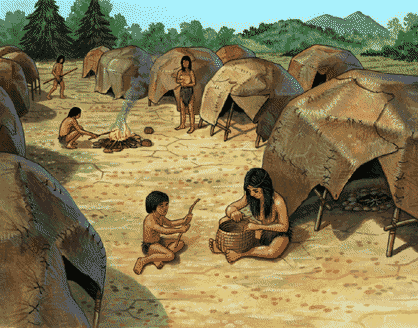Science news

8-May-2008 14:00 Eastern US Time
New evidence from earliest Americans
The remains of a dozen huts in a peat bog 500 miles south of Santiago have provided new evidence of the earliest human settlement in the Americas. This supports the theory that humans migrated south along the Pacific Coast more than 14,000 years ago.
The study was carried out by a team of anthropologists, geologists and botanists headed by Vanderbilt University’s Tom Dillehay. It was reported in the May 9 issue of the journal Science.
The paper contains the first new data reported from Monte Verde in 10 years. It includes the identification of nine species of seaweed and marine algae. These were recovered from hearths and other areas in the ancient settlement.
The seaweed samples were dated between 14,220 to 13,980 years ago. This confirms that people lived in the upper layer of the site - Monte Verde II - more than 1,000 years earlier than any other reliably dated human settlement in the Americas.
The Monte Verde site was discovered in 1976. It has well-preserved ruins of a small settlement of 20 to 30 people living in a dozen huts along a small creek. A wide variety of foods have been found at the site. These include shellfish, vegetables, nuts, an extinct species of llama and an animal called a gomphothere, which was something like an elephant.
Almost twenty years ago Dillehay and his colleagues first reported that radiocarbon dating of the bones and charcoal found at Monte Verde gave dates more than 14,000 years before the present. This stirred up a major controversy. These dates disagreed with other archaeological evidence for when North America was first settled.
Since at least 1900, the accepted theory had been that human colonisation began at the end of the last Ice Age. This was about 13,000 years ago, when groups of big-game hunters, called the Clovis culture, followed herds from Siberia to Alaska over a land bridge
They crossed the Bering Strait, it was believed, and then gradually spread southward. The Clovis artefacts were all from 13,000 years ago and later. So a much earlier human settlement in southern Chile was hard to fit with this picture.
It wasn’t until 1997 that the puzzle was solved. A group of archaeologists reviewed the evidence, visited the Monte Verde site and unanimously approved the dating.
Most scholars now believe that people first crossed the Bering land bridge more than 17,000 years ago. They then spread quickly down the coast. The general view is that the early immigrants moved south along the shoreline much more easily than they moved inland.
This is because they could find food and resources along the coast that weren't too different from what they were used to. But evidence to support this coastal migration theory has been hard to find. This is because sea levels at the time were about 200 feet lower than today: As the sea level rose, it covered most of the early coastal settlements.
According to Dillehay, the new Monte Verde findings support the coastal migration theory. But they also raise the possibility that the migration was much slower than was thought.
Monte Verde was situated on a small tributary of a large river. It was about 400 feet above sea level, more than 50 miles from the coast. It was 10 miles from a large marine bay. Despite the inland location, the researchers found nine different species of seaweed and algae in the material collected at the site. The Monte Verdeans must have carried this material from the coast and the bay.
The researchers also found a variety of other beach or coastal resources. These included bitumen, flat beach pebbles and water plants from brackish estuaries.
Finding seaweed wasn’t a surprise, says Dillehay. “But finding five new species in the abundance that we found them was."
There are other coastal resources at the site, he added. "The Monte Verdeans were really like beachcombers: The number and frequency of these items suggest very frequent contact with the coast, as if they had a tradition of exploiting coastal resources.”
The scientists also found a number of inland resources in the ancient village. These included gomphothere meat. This suggests that the group was moving back and forth between different ecological areas - a process called transhumance.
It takes time to adapt to inland resources and then come back out to the coast, Dillehay says. "The other coastal sites that we have found also show inland contacts."
Perhaps all the early Americans also moved back and forth between inland and coastal areas, he suggests. If so "then the peopling of the Americas may not have been the blitzkrieg movement to the south that people have presumed, but a much slower and more deliberate process.”
More help with words
| breed | fertile | generation | hypothesis | origins |
| reliable | tentative | thoroughly | tide |
What's it all about?
- What have the scientists been studying?
- Who carried out the study?
- What did they use to find out when people lived in the huts?
- How long ago did people live there?
- Roughly how many people lived in Monte Verde?
- Name three of the foods that they ate.
- For at least how many years has Tom Dillehay been studying the site?
- Why did the findings he reported that many years ago cause a big fuss?
- Who were thought, since about 1900, to be the first humans in America?
- Where did they come from?
- How did they get their food?
- Once scientists studied the evidence at Monte Verde, they realised that the Clovis people were not the ----- humans in America.
- Most of the experts now believe humans came to America almost 17,000 years ago and moved rapidly down the -----.
- The new evidence from Monte Verde supports only part of this picture. Which part?
- Which part does it raise questions about?
- The Monte Verde settlement was about 50 miles from the coast. But the scientists found a number things there that the people carried from the coast. Name three of them.
- They also found things from further inland, including ---------- meat.
- This means that the Monte Verde people were moving back and forward between different types of area. What is this called?
- Why does this raise doubts about the theory that humans moved quickly down the coast after they first came to America?
- Think of one question you still have about all this.
- If you were one of Dillehay's team what would you like to do to try find an answer to that question?

